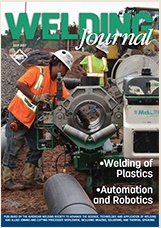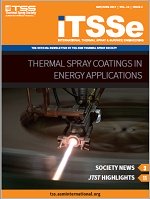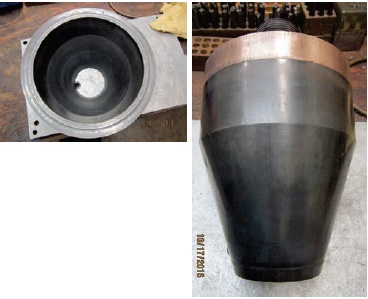| Back to Back Issues Page | ||||||||
 |
||||||||
|
PWL#168, Safe Robotic Welding, Planning for new automation, Nuts welding to HSLA, TS success story August 01, 2017 |
||||||||
| We hope you will find this Letter interesting and useful. Let us know what you think of it.
PWL#168
PWL#168, Making the Standards for Safe Robotic Welding, Reducing financial risk when implementing automation, Resistance Projection Welding Nuts to High-Strength Low Alloy (HSLA) Steel, Thermal Spray Success Story, How 80/20 rules metal fabrication, Beyond the Welder and much more...
August 2017 - Practical Welding Letter - Issue No.168
DON'T USE REPLY to
send your messages! Use the Contact Us form instead. This publication brings to the readers practical answers to welding problems in an informal setting designed to be helpful and informative. You are urged to pass-along this publication to your friends, if you like it, and if you think they may enjoy it. The addresses reported hereafter were live and correct at the time of their publication. Note: References to articles or other documents are given here in one of two forms. If they are URL's (Uniform Resource Locator), which is the analogue of an address, they begin with "http://..." or "www.". If the information is
important to you as we hope, you may save the selected pages in a suitable folder on your Computer for easy reference.
1 - Introduction 2 - Article - Making the Standards for Safe Robotic Welding 3 - How to do it well: Reducing risk when implementing automation 4 - Resistance Welding Nuts to High-Strength Low Alloy (HSLA) Steel 5 - Online Press: recent Welding related Articles 6 - Terms and Definitions Reminder 7 - Article: Thermal Spray Success Story 8 - Site Updating: Thermal Spray 9 - Short Items 10 - Explorations: beyond the Welder 11 - Contributions: How 80/20 rules metal fabrication 12 - Testimonials 13 - Correspondence: a few Comments 14 - Bulletin Board
2 - Article - Making the Standards for Safe Robotic Welding
Is working with welding robots safe from dangers to humans? It should be, if a strict discipline to follow the rules, established by applicable Standards, can be enforced on all who may interact with the machines. A new article, published at page 34 of the July 2017 issue of the Welding Journal, describes the work of AWS technical Committee D16, already active for more than 30 years. Its endeavors concentrate on the development, creation and publication of recommended practices and standards. Starting from 1991, the need was perceived for robotic arc welding safety standards to tackle all circumstances connected with hazards of robot systems producing welded components. The authors report on a disagreement within the robotic industry, on safety standards of general nature, versus those developed with a narrow focus on the specific technology of given applications. The members of the D16 Committee believe that specific standards provide the highest benefit to users. Much work still waits to be done to produce safety standards concerning robotic welding for the processes GTAW, Resistance, laser and friction stir welding. The Committee is quite busy but has no intention of slowing down or avoid impending obligations. Interested readers are invited to seek the original article.
3 - Reducing investment risk when implementing automation
While investing in welding robots can reduce the struggle to find expert welders and improve productivity and quality, one can reduce the economic risks by adopting suggested steps. These are listed in a recent article published at page 44 in the July 2017 issue of the Welding Journal by an automation product specialist. Start small is the first suggestion. It makes sense that the larger the parts the more complex will be the robot to be selected for performing the job. Moreover the variation in tolerances stack up in a large part, multiplying the difficulties. By heeding this advice the costs incurred in correcting surfacing problems like fixturing issues and extra programming are less expensive. The second step recommends to start with simple weld joints and parts. The easiest to weld successfully are fillet and basic lap joints. This selection helps control the repeatability of the joint within one half the wire diameter. An essential part of more complex joints, root opening, recommended at one half of the thinnest member thickness, may be difficult to maintain, with the limited experience of a starting up operation. Repeatable and accurate upstream fabrication is an essential key to success. Therefore great efforts must be dedicated to obtain parts perfectly fitting the fixtures. Also timing must be kept under control to optimize workflow. A rule of thumb is proposed in the above exposition: to maximize the return on capital investment, a robotic welding system should produce roughly a 3-to-1 gain over what a human welding operator can achieve. Can our expert readers confirm that this goal can be met? The fourth recommendation refers to speed. The author considers a mistake operating the robotic welding system at full speed from start. Trying first slowly, at about a quarter speed, permits to check misalignments or crashing the robot against part or fixture. Increasing speed gradually allows to correct inconsistencies before running at full speed. Lastly the author reminds that part of the investment in automation should include the right people with complete training, given by the original equipment manufacturer, to support the system. He is confident that, by following the recommendations, one can maximize the investment, ensuring the success of automated welding system from start to finish. Interested readers are urged to seek the original article, whose author can be contacted if necessary.
4 - Resistance Welding Nuts to High-Strength Low Alloy (HSLA) Steel
Answering to a puzzled inquirer who found the hard way that old schedules were failing specification requirements, the three experts signing the Resistance Welding Manufacturing Alliance (RMWA) Q&A column at page 26 of the July 2017 of the Welding Journal comment that the difficulties stem from extra hardness and inconsistent surface condition of the stronger newer material. They point out that when the strength of sheet metal exceeds 700 MPa, and may reach 1200 MPa, it is difficult to forge the projections of nuts into the sheet metal without expulsion and inconsistent weld strength. The three authors recommend undertaking a thorough research and development procedure to identify and optimize the three most important variables in resistance welding: weld force (tip pressure), weld current (secondary amperage), and weld time (the duration of current flow). A combination of high weld current and short weld time is recommended because the intense heat at the projections allows the welding/forging process to take place fast before the projections are "blown out." A fast follow up device is considered essential to the success of the operation. The recommended procedure of establishing a proper weld lobe, that is a window of suitable parameters likely to provide acceptable results, is spelled out in seven steps clearly described and demonstrated. Follows in the article a discussion of different types of power supply, (AC, MFDC,CD) with their characteristics and description, and a reminder of safety precautions to be implemented. Interested readers who may confront similar problems, are warmly invited to seek the original article, and to contact the authors for further information if necessary.
5 - Online Press: recent Welding related Articles How joining a startup can help youngsters shape their career Hot nanotubes help strengthen 3D printed thermoplastics in novel welding process Cloning Master Welders with Robotics At 25, EWF’s qualification system addresses the challenges of Industry 4.0 2016 Was a Good Year for Lasers; 2017 Looks Even Better Those with an interest in Failure Analysis may find useful information in the recent Bulletin of the Electronic Device Failure Analysis Society, of May 2017, Volume 19, Issue 2 available from Although most of the articles are too specialized maybe, some address generalized problems likely to be well received by curious readers.
6 - Terms and Definitions Reminder Refractory Metals, by convention, are those with a melting point greater than 2000 °C (3,630 °F). Slag is a nonmetallic product resulting from the mutual dissolution of flux and nonmetallic impurities in smelting, refining, and certain welding operations. In steelmaking operations, the slag serves to protect the molten metal from the air and to extract certain impurities. Tack Weld is made provisionally to hold components in alignment until final welds are made. Usability is a measure of the relative ease of application of a welding filler metal to make a sound weld. Vacuum Melting is melting in a vacuum furnace to prevent contamination from air and to remove gases already dissolved in the metal. The solidification can also be carried out in a vacuum or at low pressure. Wash Pass is a nonstandard term used to mean a cosmetic weld pass or a cover pass. X-ray topography is a technique that comprises topography and x-ray diffraction. The term topography refers to a detailed description and mapping of physical (surface) features in a region. In the context of the x-ray diffraction, topographic methods are used to survey the lattice structure and imperfections in crystalline materials. Yield is the evidence of plastic deformation in structural materials. Also known as plastic flow or creep.
7 - Article: Thermal Spray Success Story
Blow molding and plastic injection molding technologies are used to mass produce parts made of plastics like glass filled nylon material. Unprotected tooling components made of wear resistant metals suffered from wear, producing nonconforming parts and production disruption. Applying by the high velocity oxy-fuel (HVOF) process a thin layer (0.010 in.) of tungsten carbide and then grinding to the required surface finish, increased tooling duration from 8 months to more than 23 months. A short article published in the iTSSe newsletter mentioned already in the last PWL issue provides all the details. Interested readers can obtain the publication from ASM International. On another subject, please be informed that SPRAYTIME - Second Quarter 2017 / Volume 24 - published by the International Thermal Spray Association, a standing Committee of the Ameerican Welding Society, is available for download from: Recommended at page 14 is an article on:
Blow mold head tooling (die and pin) coated with a tungsten carbide/cobalt matrix after 19 months in service. [From iTSSe May-June 2017 - Vol. 12 - Issue 2 - page 10 (44)]
8 - Site Updating: Thermal Spray The updated website page contains, among other editing, a reference to this PWL#168, specifically to column (7) reminding a thermal spray success story, and the availability of a new brochure from ITSA (International Thermal Spray Association). The revised page can be read by clicking on Thermal Spray. It is hoped that people working on these processes are alert to all information regarding safety, like that reported in the publication indicated above. 9 - Short Items 9.1 - Gouging is, in welding practice, the forming of a bevel or groove by material removal. 9.2 - Heat-affected zone (HAZ) craking, is that appearing in the portion of the base metal that was not melted during brazing, cutting, or welding, but whose microstructure and mechanical properties were altered by the heat. 9.3 - Ion Implantation is the process of modifying the physical or chemical properties of the near surface of a solid (target) by embedding appropriate atoms into it from a beam of ionized particles. 9.4 - Jominy test or end-quench hardenability test is a laboratory procedure for determining the hardenability of a steel or other ferrous alloy; widely referred to as the Jominy test. Hardenability is determined by heating a standard specimen above the upper critical temperature, placing the hot specimen in a fixture so that a stream of cold water impinges on one end, and, after cooling to room temperature is completed, measuring the hardness near the surface of the specimen at regularly spaced intervals along its length. The data are normally plotted as hardness versus distance from the quenched end. 9.5 - Knurling means impressing a design into a metallic surface, usually by means of small, hard rollers that carry the corresponding design on their surfaces. 9.6 - Leak Testing is a nondestructive test for determining the escape or entry of fluids (liquids or gases) from pressurized or into evacuated components or systems intended to hold them. Leak testing systems, which employ a variety of gas detectors, are used for locating (detecting and pinpointing) leaks, determining the rate of leakage from one leak or from a system, or monitoring for leakage.
10 - Explorations: beyond the Welder Novel Gene Therapy for Leukemia Clears FDA Panel LHC Physicists Unveil a Charming New Particle North Korea Missile Test: Best Response May Be Surprisingly Low-
Tech Tripping on Peyote in Navajo Nation Students are Better Off without a Laptop in the Classroom
11 - Contributions: How 80/20 rules metal fabrication A recent article with the above title from stresses how important it is for fabricators to "maximize some results, like sales or profits, by systematically deploying available resources only to the drivers that have the most impact". What exactly is the high-impact 20 percent? To answer this question, a company first needed to uncover the current state, including the true velocity of jobs on the manufacturing floor: what moved quickly and what didn't. Three years ago the firm upgraded its enterprise resource planning system (software) that gives everyone that kind of visibility. The company had built its processes around certain quality requirements that were appreciated by their customers. Cheaper solutions were not the answer. In an interview the general manager of that company said: "The bottom line is this: Customers like engaging in transactions with people they enjoy and whom they trust. You maximize their dollar and add value, because you bring things to the table that your competition isn't doing." This wisdom is probably applicable to the majority of industrial fabrication enterprises: it may be rewarding to look for ways to implement the lesson of this simple rule. Readers may check the article at the above link.
12 - Testimonials On Sun Jun 25 01:07:40 2017, the following results were submitted from the "Form 5" on welding-advisers.com: Name: PRIYANK JAIN
13 - Correspondence: a few Comments DON'T SEND US YOUR INSTRUCTIONS! A small number of our subscribers nurture toward us useless illusions they should abandon asap. They think that if they send us a scrap of notice containing an instruction on how we should behave, that is going to happen instantly. They are
WRONG! Don't fall into the trap to inform us that your email address is no longer valid. If you want to ask us to CHANGE your subscription address, please conform to our requirement If you want to leave our readership, please UNSUBSCRIBE. In any case don't come to us with the absurd request that we VALIDATE our legitimate delivery,
based on your independent and no cost decision to subscribe, You may accept or reject these facts of life.
14 - Bulletin Board
14.1 - Weld Repair Conference 14.2 - ATI Annual Technology Fair. 14.3 - Global Automotive Lightweight Materials Detroit Congress. 14.4 - Westec.
See you next time...

Watch - The Video:
and also
BUILT BY: Click on this Logo NOW! No better way to get to know SiteSell, Specific questions about SiteSell?
Copyright (©) 2017, by Elia E. Levi and
Back to Past Issues of PWL.
|
||||||||
| Back to Back Issues Page |


